Xuán Zàng 玄奘 was a leading figure in the development of Buddhism in China. In the 7th century, he traveled along the Silk Road to India to collect Buddhist scriptures that shed light on religion as it was understood in China at that time.
Birth and childhood
Born in 599 in the vicinity of Luòyáng 洛阳, Xuán Zàng belonged to a noble family whose ancestors had held important military positions. In his childhood he received a Confucian education according to his ancestry. However, destiny wanted him to become an orphan at an early age, taking his mother when he was five years old, and his father at ten, and entering a Buddhist temple in Luòyáng, where at the age of thirteen he was ordained as a monk.
In his youth civil war ravaged the region and Xuán Zàng sought refuge in the capital, Cháng’ān 長安 (current Xī'ān 西安). It is the end of the Suí dynasty 隋朝 and the beginning of the great Táng dynasty 唐朝.
Avid for knowledge, Xuán Zàng traveled for seven years through China seeking a deep understanding of Buddhism, studying classical texts and visiting scholars and monks. However, what he finds is confusion regarding the scriptures and interpretation of the texts. The Chinese scriptures were incomplete and poorly translated, resulting in frequent misinterpretations and the proliferation of different schools of Buddhism at odds with each other.
Despite the risk of being caught, Xuan Zang undertakes the trip without carrying an imperial safe conduct.
On his return to Cháng’ān in 625, Xuán Zàng meets an Indian monk named Prabhakaramitra; he begins to appreciate Indian Buddhism and to wonder about the true essence of the Buddha's teachings. Determined to find this essence, he wishes to make a pilgrimage to India in search of answers. He and other monks make a formal request to the imperial court requesting permission to travel, but the petition is rejected and they are forbidden to leave the country. In the 7th century the empire exercises a strict control of the borders.
Pilgrimage
In the year 627 a great famine struck the capital, and the authorities allowed citizens to leave Cháng’ān. Xuán Zàng sees his opportunity and undertakes the trip without having an imperial safe conduct. He travels by land, following the same route that Zhāng Qiān 張騫 opened when he traveled in the 2nd century B.C. seeking to establish commercial relations with the Western Regions*: the Silk Road.
After a month of travel he arrives in Liángzhōu 凉州. The empire is at war with the Turkic tribes of the west and the borders are closed; it is not possible to travel west without an imperial safe-conduct.
Xuán Zàng spends a month teaching in Liángzhōu, waiting to find an opportunity to cross the border. However, someone alerts the authorities of Xuán Zàng's intention to travel west, and the local governor orders him to return to Cháng’ān. Xuán Zàng manages to escape with help of two monks, traveling at night and hiding until they reach Guāzhōu 瓜州, on the western edge of the Táng Empire. There, a local officer stops him, carrying an arrest warrant but, as a devout Buddhist, breaks the order and lets the monk leave.
Seeking the way to cross imperial control, Xuán Zàng gets a horse from an old man who warns him of the danger of traveling west through the desert. Xuán Zàng makes the vow not to give up on his purpose even if he finds death on his way. The old man tells Xuán Zàng that if he sees himself in a critical situation, his horse will know where to go.
To get to the border crossing, the monk needs to stock up on water in a series of wells guarded by watchtowers filled with imperial soldiers, where he takes the risk of being captured.
Despite traveling at night, Xuán Zàng is discovered upon reaching the first watchtower, and is arrested. Upon learning the purpose of Xuán Zàng's trip, the garrison commander, a fervent Buddhist, frees him and provides him with water and food to continue his journey. The commander advises him to go directly to the fourth tower, where one of his relatives is in charge, and with his help the pilgrim manages to surpass the five watchtowers and enter the desert of Mòhèyánqì Gēbì 莫贺延碛戈壁 in the Héxī corridor 河西走廊, on the boundary between the current Chinese provinces of Gānsù 甘肅 and Xīnjiāng 新疆.
Xuán Zàng enters the desert alone, where he experiences visions of threatening demons, which he keeps away because of his devotion to Guān Yīn 觀音. Along the way, he loses his goat skin canteen, his only water supply. In the midst of the scorching heat and sand winds whipping his body, he turns around to return. However, regretting and remembering his vow to reach India or die on the road, he turns around again determined to continue his journey.
Xuán Zàng spends several days without water in the middle of the desert, lost and on the verge of death. Finally, practically dehydrated, his horse takes him to an oasis at the end of the desert, where both, man and beast, quench their thirst and replenish forces to continue.
After leaving the desert alive, Xuán Zàng arrives at the kingdom of Yīwú 伊吾, the first beyond the Táng empire. There, in the vicinity of current Hāmì 哈密, finds a temple where the monks offer shelter. From Yīwú, Xuán Zàng plans to continue his trip on the northwest route. However, since he was teaching in Liángzhōu, his name has become known along the Silk Road and, having heard about him, the king of Gāochāng 高昌, the largest kingdom in the vicinity and located at southwest of Yīwú, summons him to his presence.
In Gāochāng he is well received by the king, a devout follower of the Buddhist religion. Under his reign, Buddhism flourishes throughout the region, where there are more than 300 temples and 3000 monks.

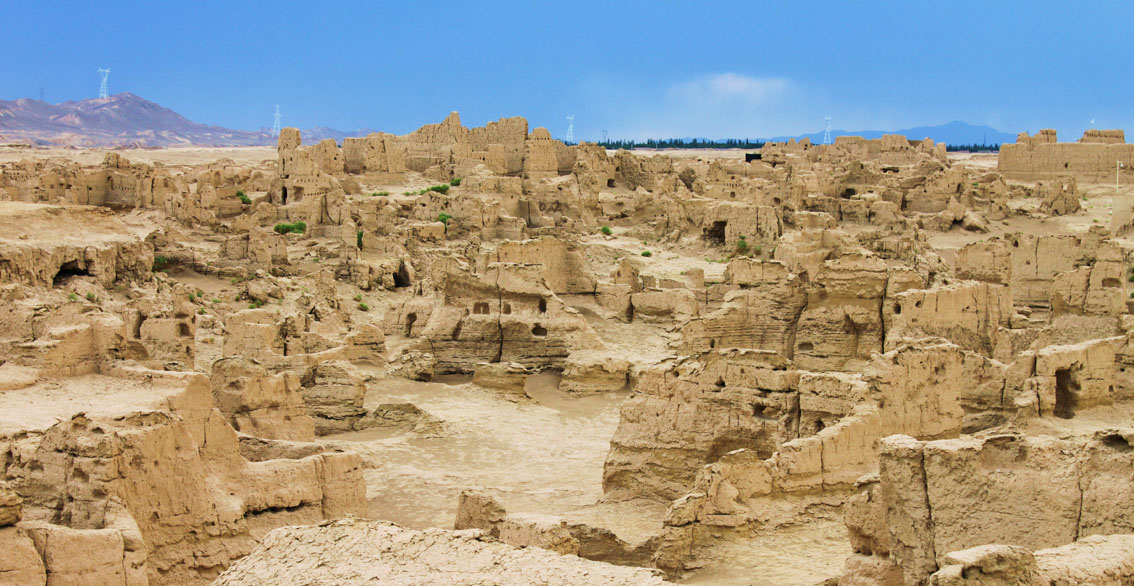
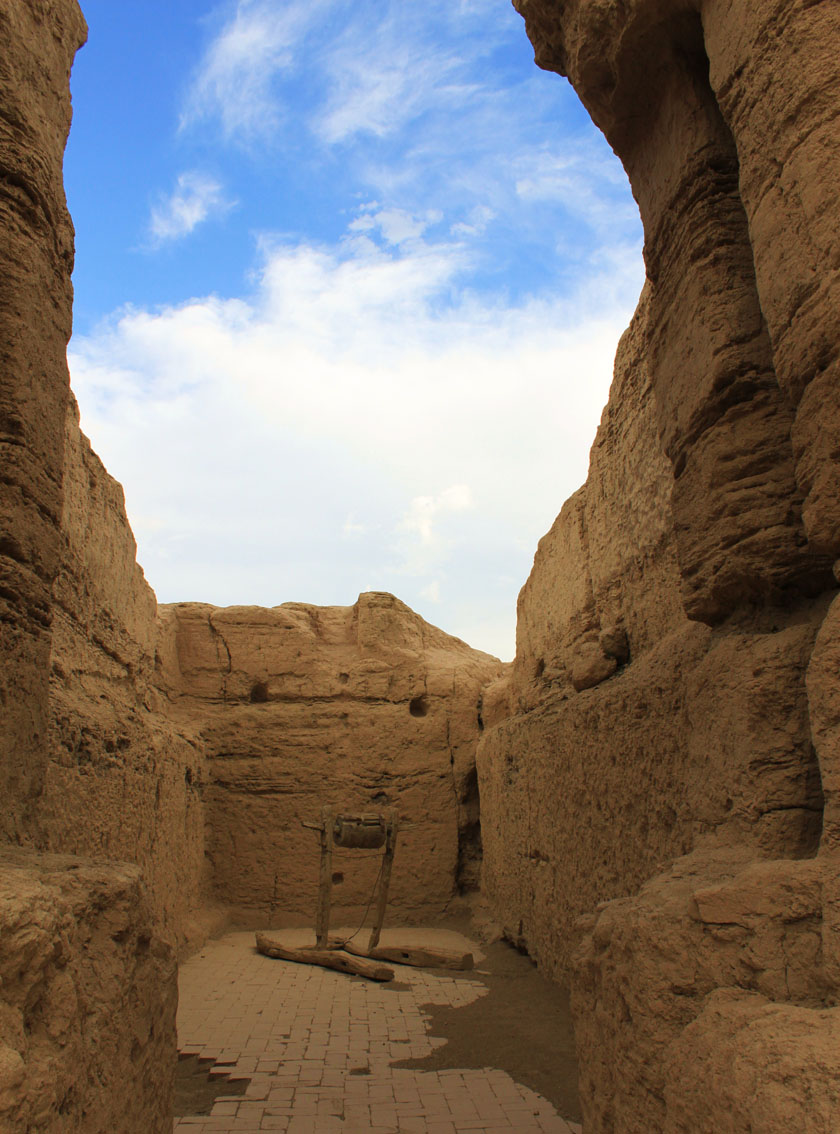
The ruins of Jiāohé 交河, an important Buddhist enclave in the ancient kingdom of Gāochāng.
The king of Gāochāng offers Xuán Zàng to stay and become a religious leader, although in reality his interest lies in getting to know better the Hàn 漢 culture, which exerts great influence in the region. Xuán Zàng rejects the king's offer, but he insists and threatens to repatriate him to the Táng empire. China is preparing for war against the nomads in the north and Gāochāng can be involved: the king needs advice and does not want to see the monk leave.
Xuán Zàng, unable to convince the king to let him go, decides to go on a hunger strike, refraining from eating and drinking for several days. Finally, the king is moved by the devotion of the monk and both swear brotherhood in front of Buddha. The king prays for Xuán Zàng's pilgrimage, and Xuán Zàng promises that on his return trip he will stop in Gāochāng and teach Buddhism for three years. The king chooses four monks to become disciples of Xuán Zàng and take care of him; he provides men and horses, and gifts for the kings of the kingdoms that he will find on the road, and he writes a letter to the Khan of the western Turkic peoples to assist them in their journey. It also provides them with money and silk to travel for twenty years. At his departure, the delegation is dismissed by the community of monks, the royal family and part of the town.
On the way they are assaulted on several occasions by bandits, but when recognizing them as monks and not as merchants, the bandits let them go alive.
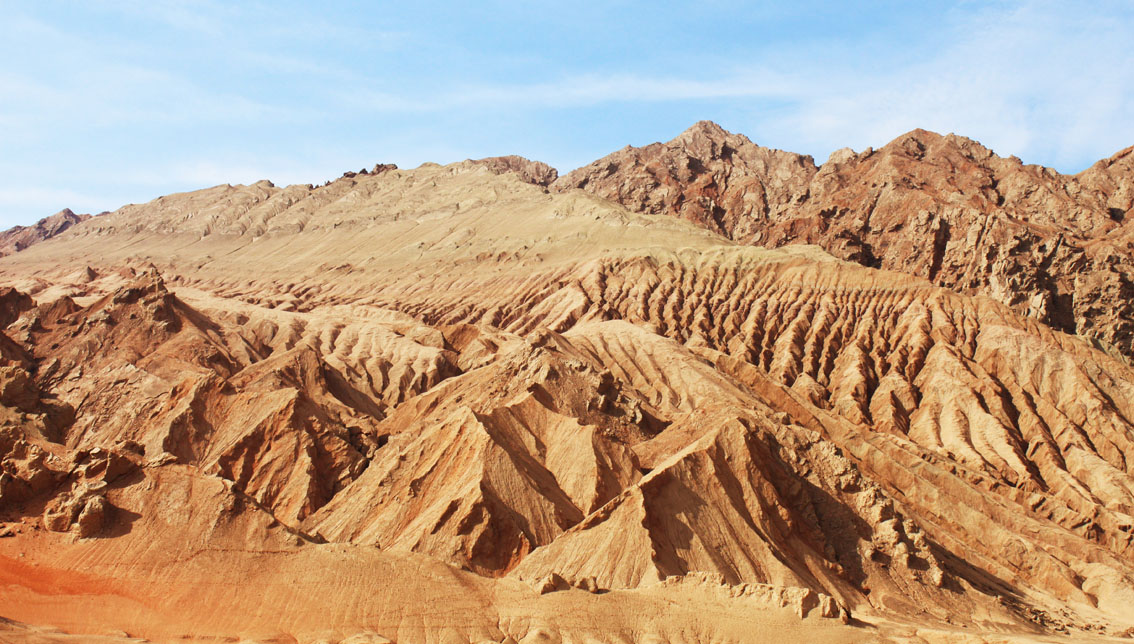
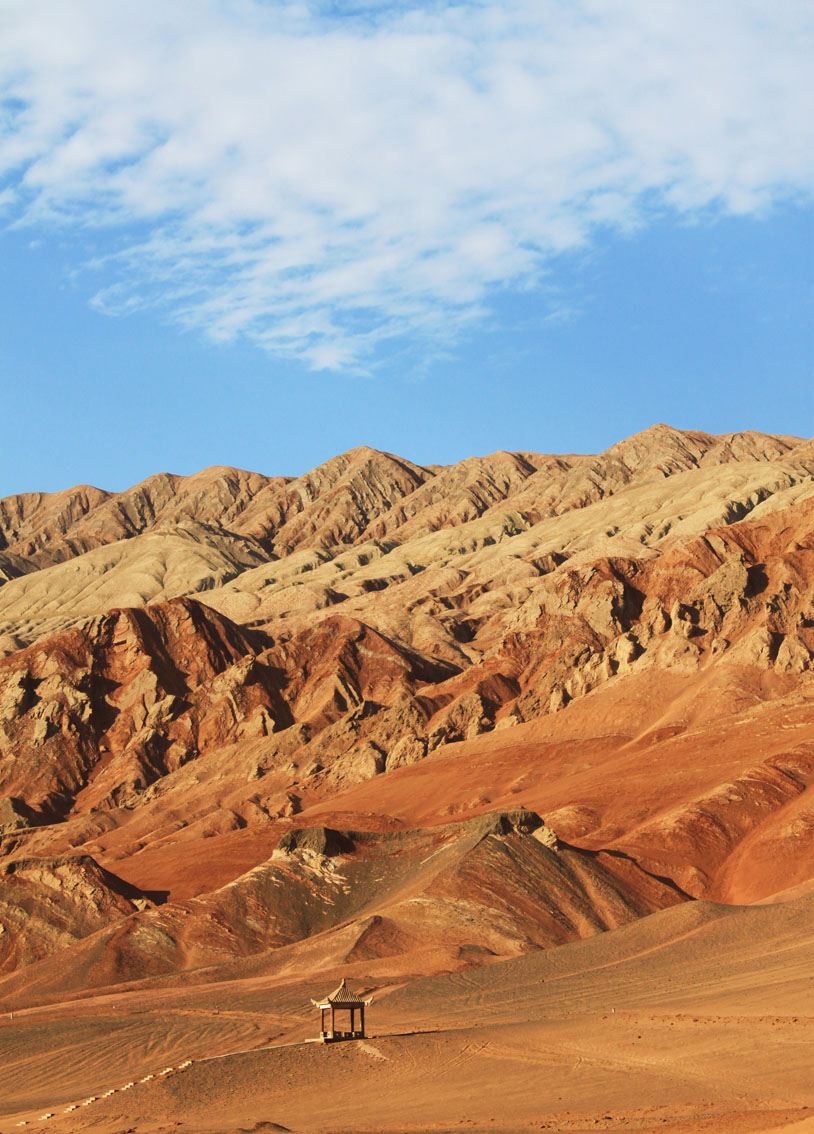
The kingdom of Gāochāng was at the foot of the Flaming Mountains (Huǒyànshān 火焰山).
After crossing the kingdom of Yanqi, Xuan Zang and his companions arrive at Kucha (Guīzī 龜茲), the most important kingdom of the Western Regions. In Kucha, Buddhism flourishes from the 1st century of our era, where it penetrated from India through the same Silk Road. There they stop for two months waiting for the arrival of spring to melt the snows in the Pamir Mountains, the next stage of their journey.
In the spring of 628, the procession departed from Kucha crossing the Pamir Mountains, at the junction of the Kūnlún 崑崙山 and Tiān Shān 天山 mountain ranges. It is not known which of the several mountain passes Xuán Zàng took on his journey, but because of extreme cold and fatigue, half of the men, including two of his disciples, and many of the horses perished on the way.
After crossing the mountains, the survivors of the group entered the steppes of Central Asia, beyond the Western Regions, passing through the Issyk Kul lake, in what is now Kyrgyzstan. In this region, the dominant religion was Mazdaism, an ancient belief of Persian origin based on the cult of fire.
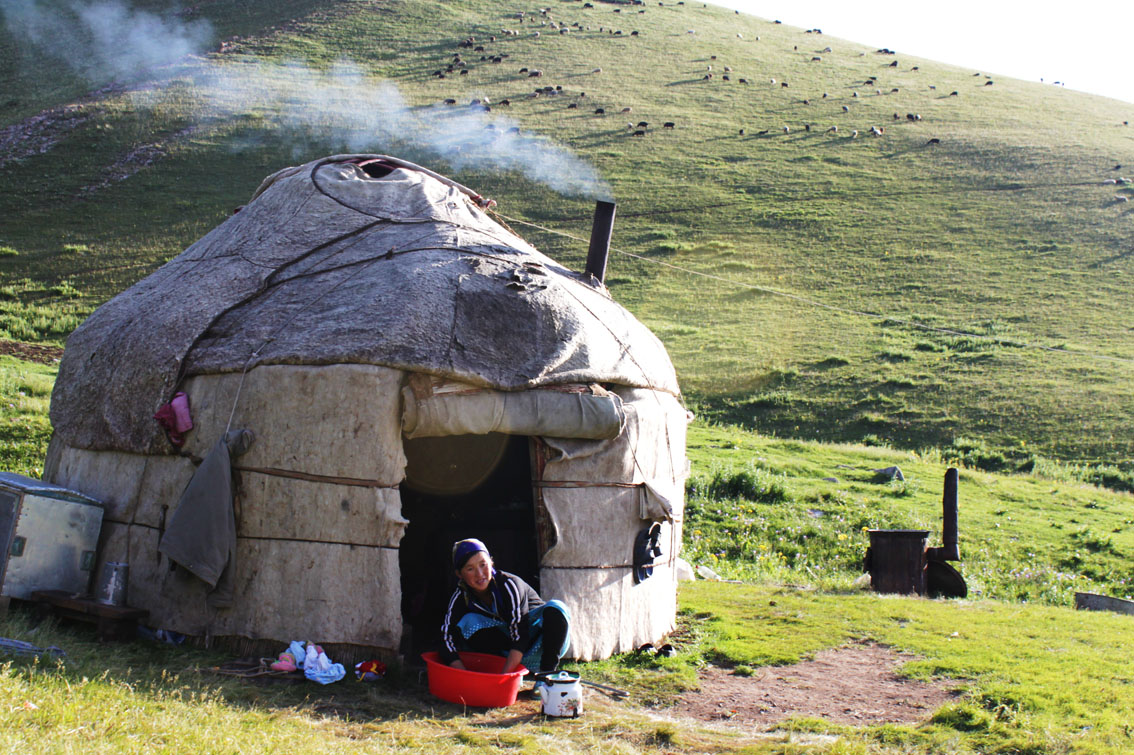
Yurt of a nomad family in Kyrgyzstan.
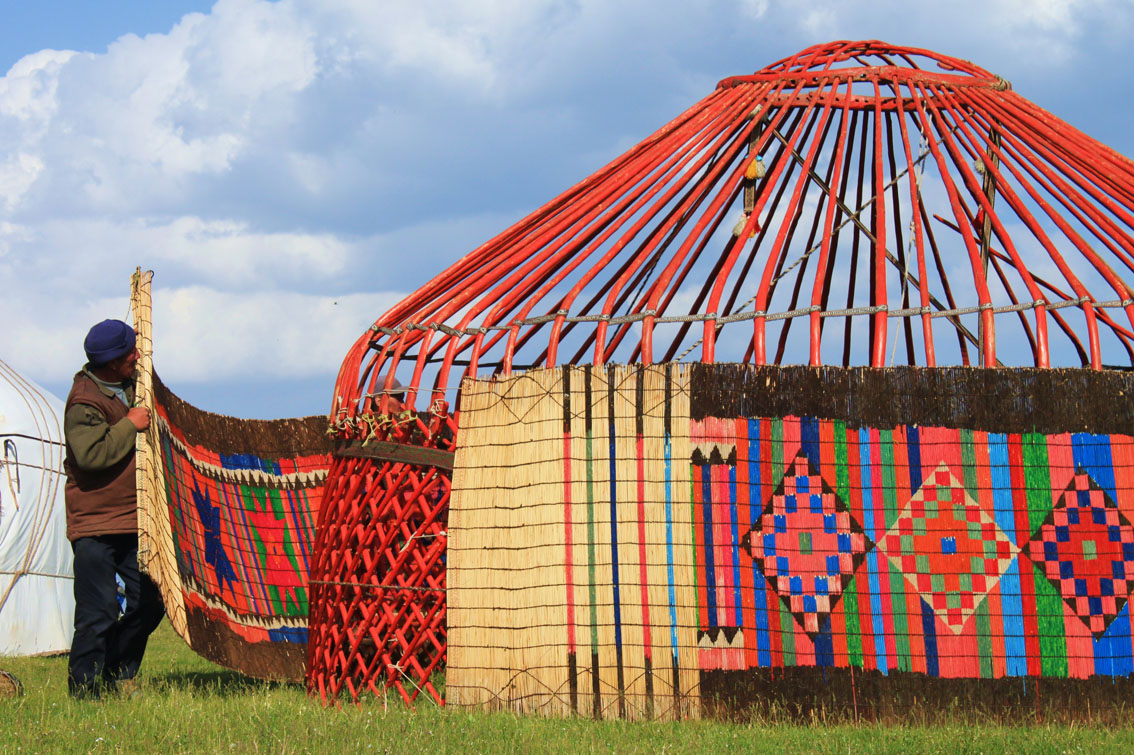
Assembly of a yurt, Kyrgyzstan.
The procession arrives at Suyab (Suìyè 碎葉), home of people of many origins along the Silk Road. When showing the letter of the sovereign of Gāochāng, the Khan of Suyab receives them well and assigns them an escort to accompany them along part of the way.
Crossing the kingdoms of Talas and Zheshi they arrive at Kand (Samarkand) in Sogdiana, one of the most important enclaves along the Silk Road. The Sogdians were a merchant people and controlled much of the trade along the route.
In Samarkand, Mazdaism and Buddhism are in conflict, and the two disciples of Xuán Zàng are attacked by the inhabitants of the city. However, the Táng culture exerts a powerful influence on the people of the region. During his stay, Xuán Zàng visits the king of Samarkand and, in a single night, his eloquence convinces him to embrace Buddhism. At that time, religious intolerance comes to an end and Buddhism begins to flourish again in the kingdom.
The delegation led by Xuán Zàng continues its journey to India, crossing Kusana to South Asia where it reaches Dami, part of the ancient Kushan empire on the banks of the Oxus**, and later to the kingdom of Huo, in present-day Afghanistan.
From Huo they have to cross the Hindu Kush mountain range and, in autumn of the year 628, they finally arrive in India. There, on the natural border of the Indus River, the Khan soldiers accompanying them from Suyab turn around, and Xuán Zàng continues accompanied only by his two disciples.
Arriving in Gandhara, formerly an important Buddhist kingdom, Xuán Zàng is saddened to realize the decline of Buddhism in the region. From the conquests of Alexander the Great, in Gandhara the Indian, Greek, Persian and Roman cultures are fused. The Buddha images produced here show remarkable similarities with Greek art, especially with the figure of Apollo.
In earlier times, Gandhara had been the center of Buddhism in India, but in the 5th century the nomads conquered and destroyed the temples marking the beginning of the decline of the Buddhist religion.
In India, Xuan Zang realized the decline of Buddhism in the region.
In the 7th century, India was formed by more than 70 independent kingdoms. In Kasmira (Kashmir), Xuán Zàng stays for a year studying Buddhist scriptures compiled in the 1st century in a great council of monks under Emperor Kanishka. He leaves Kasmira in August of 629 with the intention to head to Nalanda.
Meanwhile, the Táng dynasty goes to war with the Eastern Turkish Khaganate and begins its expansion through the Western Regions that Xuán Zàng has crossed in his journey. The power and growing reputation of the Táng empire earn Xuán Zàng the respect and admiration of the people of India.
Stay in India
In the spring of 631, Xuán Zàng arrives at the Ganges, where he is taken prisoner by a group of followers of the goddess Durga, with the intention of sacrificing him to appease the anger of the goddess. Seeing his death approaching, Xuán Zàng prays silently to the Buddha. At that time, strong winds rise, ripping the trees and destroying everything. His captors, believing then that they have offended the goddess, stop the sacrifice and release the monk.
That summer, Xuán Zàng visits several holy places of Buddhism: Kapilavastu, birthplace of the Buddha, near Lumbini in present-day Nepal; Kushinagar, where the Buddha died and attained Nirvana; Sarnath, near Benares, where he gave his first sermon after enlightenment; and finally Bodhgaya, where the Buddha reached awakening. In these places Xuán Zàng is again aware of the decline of the Buddhist religion in the country of the Buddha. Although there are still monks, many temples are demolished and few people still follow the Buddhist teachings.
In Bodhgaya, after Buddha's Nirvana, two statues of bodhisattvas were built next to the bodhi tree; among the people circulated the belief that if the statues were ever buried, Buddhism would come to an end. On his way through the place, after four years of travel, Xuán Zàng finds the statues partially buried and plunges into deep grief.
Xuán Zàng finally arrives in Nalanda in the autumn of 631, where the monks prepared him a great welcome. At that time, Nalanda was a great academic center of Buddhism, one of the few places where religion still maintained its ancient splendor. In Nalanda lived more than ten thousand monks dedicated to the study, not only of religion, but also of medicine, mathematics and many other branches of knowledge.
There, Xuán Zàng establishes a great relationship with the old abbot, Silabhadra, and becomes his disciple. Everyone treats the traveler with great consideration, providing everything necessary for his day to day.
In the spring of the following year, Silabhadra begins to instruct Xuán Zàng in the teachings of the Yogācāra school. The Buddhist texts were written on patra leaves prepared in a complicated process. These leaves were resistant to moisture and could be kept intact for hundreds of years. Xuán Zàng spent five years in Nalanda studying the scriptures and acquiring a deep knowledge of Buddhism. After this time, he spent three more years touring the Indian subcontinent to continue learning.
Back in Nalanda, Xuán Zàng takes part in a series of national religious debates, where little by little he gains great fame, and is recognized as a teacher by followers of the Mahayana and Hinayana schools. Thanks to Xuán Zàng, King Harsha, unifier of multiple kingdoms of India, becomes an important patron of Buddhism in the subcontinent.
Return trip
At the end of the spring of 641, fifteen years after leaving Cháng’ān, Xuán Zàng finally embarks on the return trip to China accompanied by a group of followers. Although he is offered to travel by boat, he decides to take the overland route by which he came, with the intention of fulfilling the promise made seventeen years before to the king of Gāochāng. Xuán Zàng takes a lot of books and writings with him. However, when crossing the Indus again, the current almost overturns them and about fifty books fall into the water, getting lost in the river.
After crossing the Pamir mountains again, the procession goes through Tashkurgan in the kingdom of Kabanda and arrives in Kashgar, where he receives the sad news of the death of the king of Gāochāng, to whom he had promised to return to teach Buddhism for three years on his trip back. Now Gāochāng is part of the Táng empire.
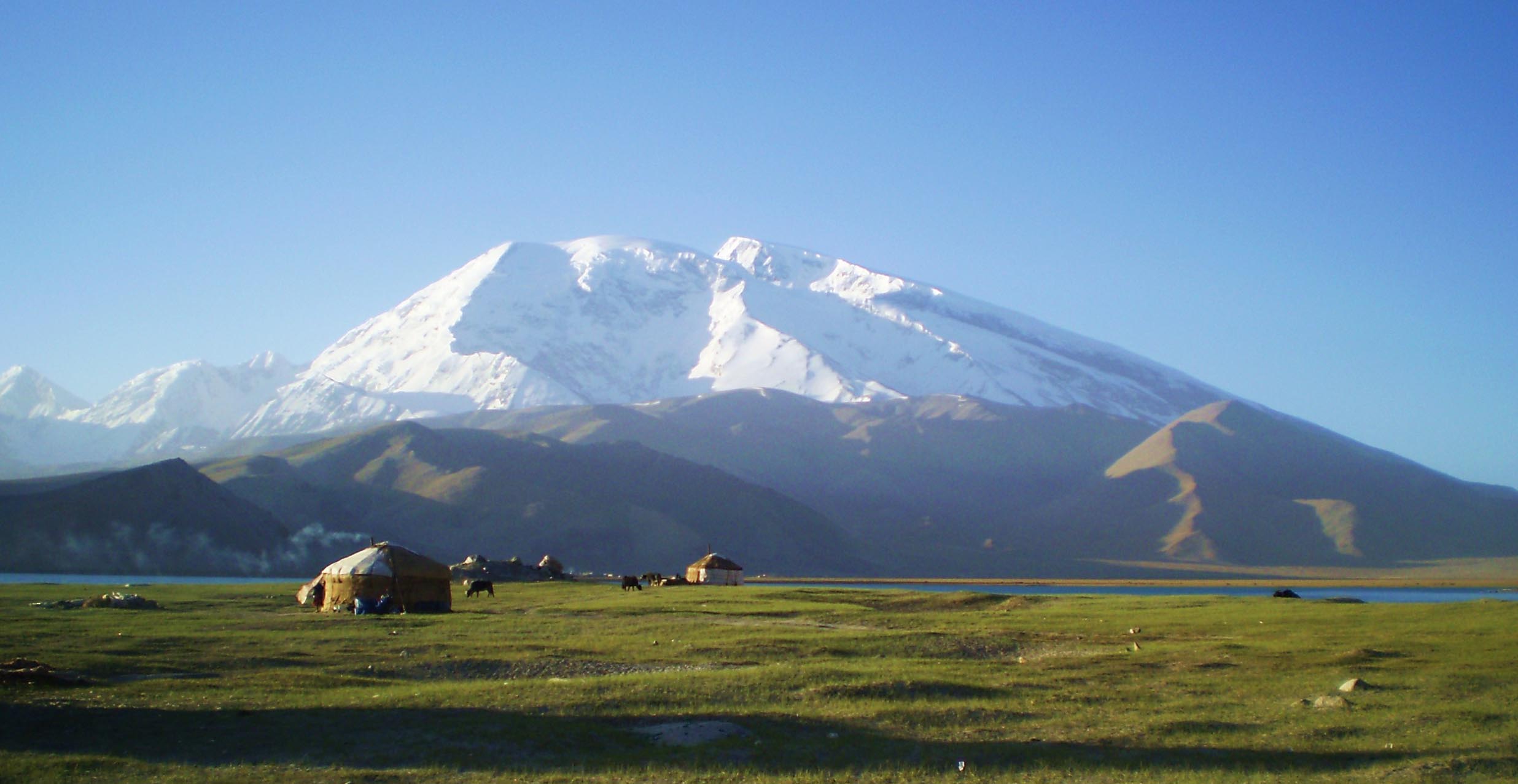
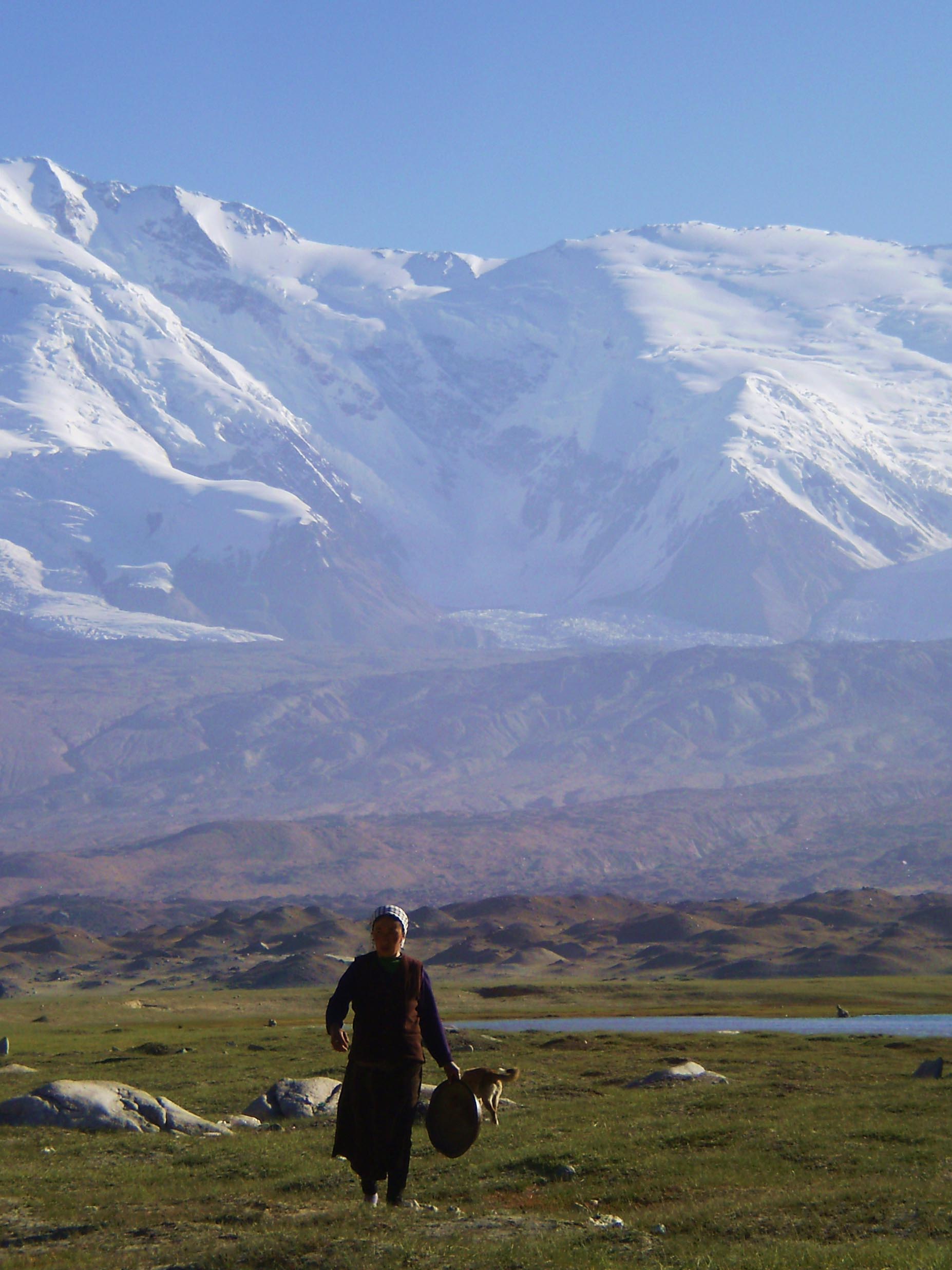
Mount Muztagh Ata by Karakul Lake, on the route that Xuán Zàng took to cross the Pamir Mountains on his return trip.
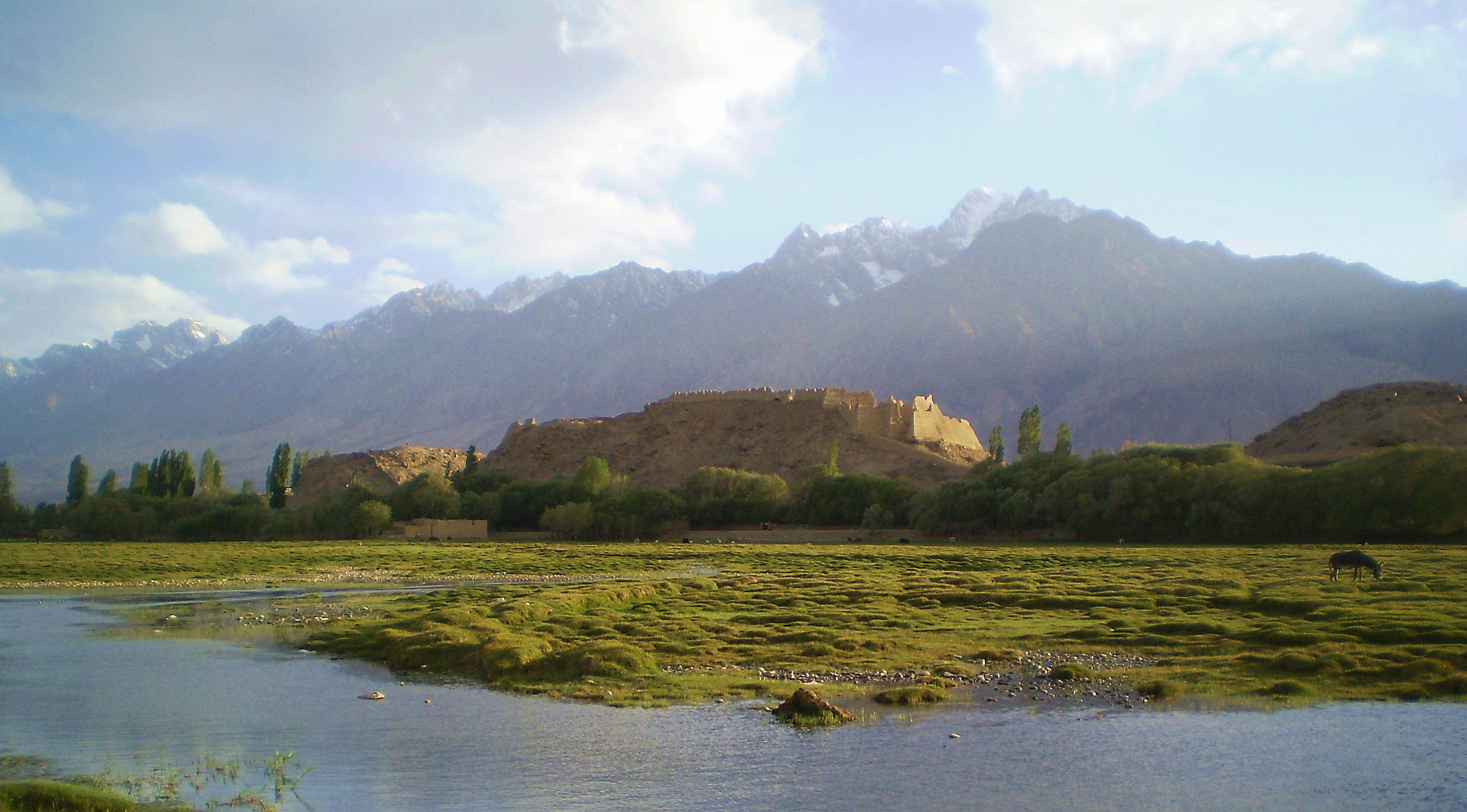
The Tashkurgan fortress.
Xuán Zàng returns by the south route of the Taklamakan and in the winter of 643 it arrives at Khotan (Hétián 和田). Before he can continue, he needs to request the Emperor's forgiveness for leaving China without permission. From Khotan, Xuán Zàng writes a letter to Emperor Tàizōng 唐太宗, from who he receives an answer six months later. The emperor grants his forgiveness and organizes his return to the capital.
After crossing the Taklamakan, they pass through Dūnhuáng 敦煌, an important Buddhist enclave on the Silk Road, and in early 645 arrive at Cháng’ān, where they are received with great ceremony.
After 19 years of travel, Xuán Zàng has traveled more than 25000 kilometers and crossed more than 100 kingdoms. On his return, he brings with him 657 Buddhist scriptures. Although his pilgrimage ends, there is still a lot of work to be done.
Translation of the sutras
Xuán Zàng is received by the emperor, who, eager to control the trade of the Silk Road, orders him to write the account of his travels, detailing the geography and customs of the Western Regions. The "Great Tang Dynasty Record of the Western Regions" (Dà Táng Xī Yù Jì 大唐西域記) is a text of great importance even in our days. Before Xuán Zàng, other pilgrims had already traveled those roads, but none of them documented their journeys. In India, there are hardly any historical accounts prior to the 18th century. The Indian people seemed more inclined to leave written myths and legends than real history. In these circumstances, the Xuán Zàng account is a very valuable source to know the facts and customs of the time.
In Cháng’ān, the Son of Heaven offers the monk a position in government, but he declines. With funds provided by the emperor, Xuán Zàng establishes a translation department, bringing together qualified monks from throughout the empire. He translated many of the most important Mahayana texts into Chinese and wrote commentaries to them. His influence promoted Buddhism under the Táng dynasty, and the number of monks increased considerably.
Xuán Zàng was appointed abbot of a new temple in Cháng’ān. However, the support he receives from the emperor suffers due to the execution of one of his disciples because of rumors about his relationship with the princess of Cháng’ān.
Latest years
In 649, Emperor Gāozōng 唐高宗 inherits the empire after Tàizōng 's death, and Xuán Zàng partly recovers imperial favour. In 652 the Great Wild Goose Pagoda was built in Cháng’ān, designed by Xuán Zàng based on a stupa of Nalanda to house the scriptures brought from India and the translation centre. The Pagoda was built in mud and brick due to the difficulty of finding stone in the surroundings, but collapsed shortly after its construction. Later, at the beginning of the 8th century, the Pagoda was rebuilt and new floors were added, but later wars partially destroyed it and it was reduced to the seven floors it still possesses today.
Gāozōng transforms the Yùhuá 玉华 palace in Shaanxi (Shǎnxī 陕西) into a Buddhist temple, where Xuán Zàng spends his last years. There, Xuán Zàng plants some bodhi tree seeds brought from India, and devotes his last years to the translation of the Mahaprajnaparamita Sutra, the longest Buddhist text, a formidable task. His disciples suggest that he eliminate all those superfluous passages, but Xuán Zàng insists on producing a strict translation. The task takes four long years.
After finishing the translation of the Mahaprajnaparamita Sutra, he begins the translation of a new text, but he feels his strength waver. Xuán Zàng leaves this world on February 5, 664, at peace with himself, and enters Nirvana. After his return from India, he spent 19 years translating 47 sutras comprised of 1335 volumes.
Xuán Zàng wanted his body to be wrapped in simple trappings and to be buried in a quiet place. It is said that at his funeral, the number of people among Buddhists and seculars exceeded one million.
Xuan Zang is a figure of great relevance in the history of cultural exchange between China and India.
Legacy
The work of Xuán Zàng helped clear up confusion in the Chinese Buddhist scriptures of the time. It established the Yogācāra school in China, where it was renamed Fǎ Xiāng 法相宗, and later it was transmitted to Japan under the name of Hossō, where it still exists today. His philosophy and his deep analysis of the mind were foreign to the Chinese tradition, and the school did not last long in the country after Xuán Zàng's death.
Most of the scriptures that he brought with him from India have been lost. At some point in history, his tomb was looted and relics of his bones lie in different parts of China. In 1957 the Chinese government gave a small fragment of its parietal bone to India as a symbol of friendship; it is currently preserved in Nalanda.
Xuán Zàng is a character whose influence transcends religion; is a figure of great relevance in the history of cultural exchange between China and India. Due to his influence, King Harsha sends embassies to Táng China, initiating a diplomatic relationship between the two countries for the first time in history.
Indian Buddhism, despite living a new boom under the reign of Harsha, ended irreversibly decaying. The destruction of Nalanda in the 12th century by invaders of Central Asia marked the end of Buddhism in India, after more than fifteen hundred years since its birth in the time of the Buddha.
The journeys of Xuán Zàng inspired centuries later the famous Chinese epic novel "Journey to the West" (西遊記 Xī Yóu Jì), where a mythological version of his travels in search of Buddhist scriptures is narrated accompanied by Monkey King Sūn Wùkōng 孫悟空. This mythological character of supernatural powers is perhaps based on the Indian monkey-god Hanuman, whose stories may have spread to China through the same paths that Xuán Zàng traveled.
Notes:
* The Western Regions is the name by which the Chinese Empire knew the lands that extended to the West beyond their domains. Currently they correspond to the Chinese province of Xīnjiāng.
** Current Amu Darya.
